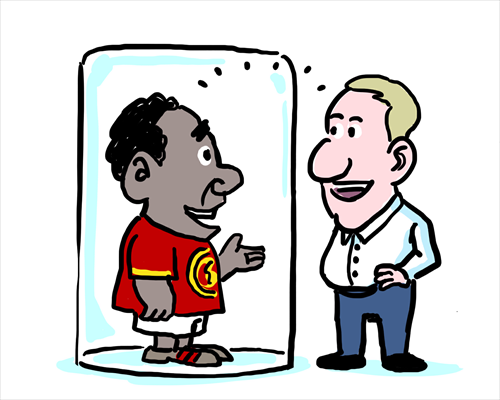HOME >> OP-ED
Self-segregation can reinforce prejudice
By Rong Xiaoqing Source:Global Times Published: 2014-9-4 18:48:01

Illustration: Liu Rui/GT
The riots in Ferguson, Missouri may have died down by now. But the pain will linger for a long time. And the lessons to be learned are only just emerging.
Many reporters were quick to point out that the Ferguson cops are almost all white in a largely black community. That contributed a lot to the tension between the police and local people, which almost certainly played a part in the deadly shooting of the unarmed black teenager Michael Brown and certainly helped to fuel the unrest that followed.
But few mentioned that the tension between law enforcement and the black community is only part of the problem in Ferguson. The lack of interaction between the black community and the outside world is also an issue.
I talked to a few residents and shop owners living in Ferguson, a St. Louis suburb, but not in the all black neighborhood where the shooting took place.
They are mainly white and some of them grew up in Ferguson. They nevertheless were all caught off guard by the riots.
Some told me they had never experienced racial tension. One person who lives only four miles away from the scene of the shooting said he didn't know that the part of town that includes a public housing complex was part of Ferguson.
These are not crazy white supremacists but ordinary middle class people who showed great sympathy toward the protestors. But it may still be hard for them to understand the struggles the black community has been going through over the years.
And vice versa. Ruby Curry, the interim president of St. Louis Community College's Florissant Valley campus, who has been working in the Ferguson area for almost four decades, told me that many black young people there have a lot of fear of the authorities. They worry they are not going to be treated fairly. But they change quickly once they get into college, because there they can encounter a diverse world and learn how to deal with it.
As she said, the road from their old neighborhood to the college campus may only be a few blocks, but it is not an easy trip.
This is no longer the old South where white and black people were not allowed to live in the same building or even use the same restroom. But some elements that arose from legalized segregation persist.
In 1916, St. Louis passed an ordinance banning black people from moving into white-dominated neighborhoods. When a court decided the ordinance was illegal the next year, the white community tried other ways to achieve the same result. They got their own people to pledge to not sell their houses to black people.
When that was declared illegal in 1948, they tried to use zoning laws to restrict the type of houses in their neighborhoods, knowing sprawling one-family houses would deter black people with their high prices.
This worked and is still working today. Blacks were systematically excluded from the vast boom in postwar wealth that created much of the US middle classes.
Although racial segregation has been outlawed for decades, black people and other low income minorities are still forced to cluster together in neighborhoods where houses are affordable for them. It is much easier to rule against segregation based on color rather than income.
But what makes modern segregation more tenacious is that sometimes it is voluntary. Take the Chinese community in New York. When rents in Chinatown in Manhattan soared in recent years, the Chinese who were pushed out created other Chinatowns elsewhere, places where they could live with their own.
Now there are nine Chinatowns in the New York area, and some have surpassed the size of the traditional district.
Even the Chinese living on Long Island, many of them, even those who own million dollar houses are now contemplating the idea of forming a Chinatown there.
Even Chinese students who speak fluent English like to hang out with their own people at university, a pattern that is getting stronger with more Chinese students arriving to study. This has nothing to do with income levels or economic opportunities.
It is understandable that people like to be surrounded by others like them. Sometimes minorities can even benefit from that.
Some black educators believe black kids can do better in segregated schools, because they don't have any peer pressure to behave differently from white or other students. And it is also easier for such communities to send their own representatives to public offices to protect their common interests.
Indeed, in New York, many minority members of the city council wouldn't have been elected if they had not run in the districts where people from their own communities are in the majority. And many voters in minority communities simply make decisions based on the color of the candidates.
For people of color, it is a victory to elect your own. But at the same time, it also reaffirms the idea that only people of the same color can be trusted with the interests of their community. The solution becomes a problem, and segregation is pushed deeper into society.
The author is a New York-based journalist. rong_xiaoqing@hotmail.com
Posted in: Columnists, Viewpoint, Rong Xiaoqing